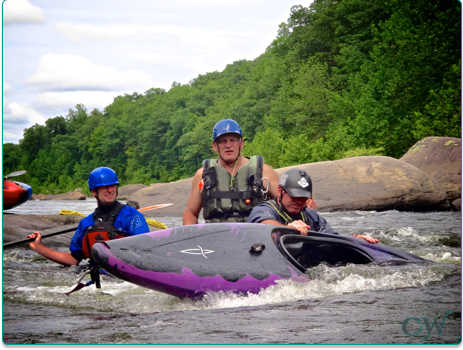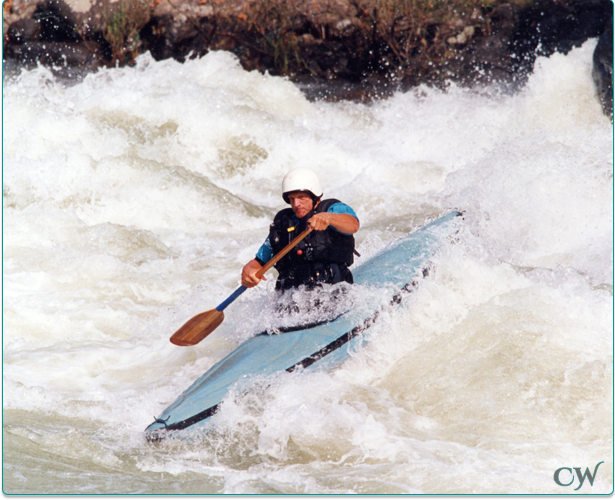Near Miss in the Watauga Gorge
The Watauga River west of Boone, North Carolina is one of the best technical river runs in the Southeast. I’d been down it a few times before, and except for a rather eventful first run with Jack Wright in the mid-70’s, had always found it enjoyable. The two previous trips had been in the company of local paddlers who knew the river extremely well. This time the gauge was reading -8″. Half our group had been down the river before, but none of us really “knew” it.
We’d been proceeding slowly and carefully, scouting the big drops as they came up. We portaged Hydro and ran everything else. We arrived at a steep boulder drop, the last major rapid above Stateline Falls, that some people call “knuckles”. I sat in an eddy while Ned Hughes scouted, then ran. He reported hitting a rock, so I got out and scouted the drop also. The base of the drop appeared shallow, but not dangerous. As I scouted, two other boaters went over. They tagged the rock lightly, but it didn’t slow them up.
My run was probably farther to the left than the others. When I hit the rock my boat stopped dead. The outfitting gave way, throwing me forward in the boat about four inches. I hesitated momentarily, then tried to push myself back upstream with my paddle. The boat slipped to the right, then settled into the drop against a left-hand boulder. Water shot into my back and flew over my head. This jammed me tightly against the front of the cockpit. I was stuck!
I knew I was in real danger. The cockpit rim was pressing hard against my hips. The deck of my C-1 was so slippery I really couldn’t push myself upstream. The current was powerful enough to knock me over if I didn’t brace myself upright. I was scared, and called for help. Peter Hubbard, who was on shore, threw me a line. This helped me stay upright, but wasn’t going to get me free. I asked him to move behind me, then I carefully tried to slide backwards without success.
Suddenly a tag line appeared above me. Ned Hughes had paddled to the center of the river, and positioned himself on a mid-stream rock. I hung my arms over it, and yelled for the group at river right to work upstream to put more bend in the rope. This improved their ability to hold on and pull. Pete, now joined by Kate Heisler and Cindy Otto, started to pull back hard. The force pushed me against my back deck, then lifted me back a few inches. My thighs came free. It was time to get out! I kicked my legs back, and slid out of the boat. My wife was preparing to run when she heard the screams and investigated. She saw me slip below the surface and thought I was gone, but fortunately this was not so. I swam to shore about thirty yards downstream, badly shaken, but otherwise OK. My boat, a full-sized Hahn Munich C-1, was completely under water and required considerable effort to pull free.
This incident came as quite a shock; afterwards my main feeling was disbelief. Although I have no illusions that my safety work provides any special protection, I consider myself a pretty careful paddler. I’m primarily into the scenery, people, and the experience, and not shy about carrying big drops. A number of people with considerable experience on the Wautauga, including a group of local paddlers who helped recover my pinned C-1, have said that the rock has been there a long time and except for a single prior incident has never caused trouble. I suspect that my long (13′) boat, carrying my 240 pound weight, dives deeper than smaller individuals in modern high-rocker designs. Or I may simply have been too far left. Either way, I simply did not read the water correctly.
It was fortunate that the remainder of my group was equipped and trained for rescue. Several of them had been students in my rescue classes, and performed well under the pressures of the moment. Ned Hughes, by moving into position, played a key role in setting up the tag line. By getting set up immediately, rather than waiting for a “leader” to give him orders, he minimized my time in the water. He held onto his end of the rope with great difficulty, but fortunately long enough. My reading and teaching gave me a good idea of what to expect; I knew what was coming and what to do. I did try to keep my sprayskirt in place as long as possible so that water wouldn’t fill the boat. Although I thought I’d released the sprayskirt before exiting, in the heat of the moment I did not. I actually came out through the waistband.
Normally a stabilization line, rather than a snag line, is used to recover alert, stable victims. The trapped person holds onto the line and uses it for support as he or she works free. But the adrenaline was flowing and the group simply pulled back hard. It was a bit uncomfortable, but it lifted me enough so I could escape. I was glad to be in a C-1; a kayak would have sunk much deeper and a paddler would have needed to work harder to get free. Although I was only pinned for a few minutes, it could have been much worse.
To those who think that they can’t get into trouble, this narrative should serve as a wake-up call. This is a dangerous sport; potential hazards are not always clearly visible and anyone can make a critical mistake. If you think that river rescue courses are somehow “nerdy” or impractical, this incident shows that the things we are teaching now really work and can make a difference. Moreover, there may not be time to improvise during an actual emergency. Experienced paddlers who are mechanically inclined may be able to get the information they need from reading books. It is sobering to think that if this had happened back in the 1970’s, I could be dead. Back then we simply didn’t know what to do.






